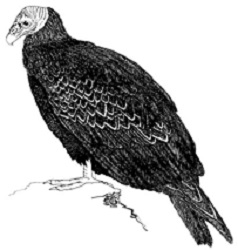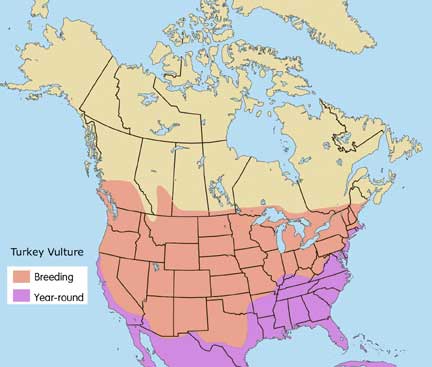
Scientific Name: Cathartes aura
This is a large, black to blackish-brown bird with a bare head and neck. Sexes are similar in size and plumage. Its beak is sturdy and pale, with large, oval, perforate nostrils; eyes are gray-brown. The long, slim, rounded tail extends more than half its length beyond folded wings when the bird is perched. The naked skin of the head and neck is black in young vultures, fades first to gray as they mature, then turns red, becoming wrinkled and warty as they reach adulthood. Although legs and feet are flesh-colored to deep red, they may appear pale due to this bird’s habit of defecating on its legs to regulate body temperature in the heat. [Courtesy of Brian Lanker] This vulture glides and soars with its wings in a tilting, flattened v-shape, circling up on thermal air currents, seeking food with its acute sense of smell. The underside of the wings show a pale, silvery lining in flight. Although it resembles a hawk when seen in the air, this bird is not a raptor. Turkey Vultures are more closely related to storks than to true vultures, like those of the Old World. The weak beak and claws of this species are not those of a predator, but of a carrion eater.
Males/Females
Length: 25 – 32″
Wingspan: 68 – 72″
Weight: 3 – 4 lb.
Federally protected.
Found in plains, farmland, deserts, and forests: wherever open foraging areas exist near trees for roosting. Ridges and hillsides are preferred in the northern part of its range, where uplands create rising air currents for soaring. Once widespread on the Great Plains in the time of the buffalo herds, this adaptable vulture now circles over roads and garbage dumps in search of meals. May establish large, communal roosts near reliable sources of food and water.
Carrion, which they find primarily by smell, but also by sight. Small carcasses are preferred, since their weak claws and bill cannot rip open thick hides of larger animals. These birds will wait for mammalian predators to open a larger carcass, or wait for the meat to decay so they can pull it apart.
Although usually silent, this bird has a number of vocalizations. These range from a short, sharp, chicken-like tschuck..tschuck..tschuck to various whines, growls, and croaks. Turkey Vultures will hiss and rattle when disturbed at a nest site; when vultures are cornered, this hissing warning may be followed by the wonderful defense strategy of vomiting up carrion.
Turkey Vultures lay their eggs on the ground in dense vegetation, in tree hollows, on rock outcrops, even on cave floors: wherever they can find a dark, protected area away from human disturbance. No nest is constructed, and the isolated sites chosen are widely spaced from other nesting pairs.
No longer legally persecuted in the US except at some large roosts as anuisance, common causes of injury to this species include being hit by cars while feeding on carrion, ingestion of lead from eating animals that have been shot, tangling in wire, gunshot, and electrocution.

This is the most widely distributed vulture in the western hemisphere. Its breeding range extends throughout North America from southern Canada down to Mexico. In winter it retreats south to the latitude of Northern California, with part of the population migrating to Central and South America. The Turkey Vulture expanded its range northward between the 1920s and 1950s, in response to a warming climate and an increase in road kill as a food source during this era of booming road construction.
Special Thanks for range maps:
Dan Gleason
BGleason Design & Illustration
Commercial & Scientific Illustration, Graphic Design
CraneDance Communications
Book Production/Design

